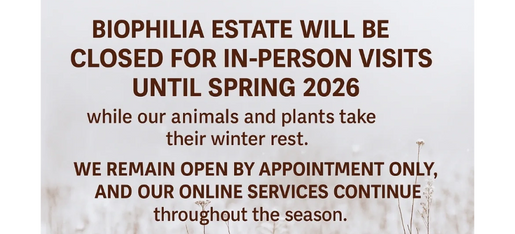Get 10% off this month

Biophilia Insights
Roots of Research
Our bond with nature is more than beauty. It is science. Here you’ll find evidence-based insights from the NIH and other trusted studies, showing how nature heals, restores, and sustains life.
What is the biophilia hypothesis?

The Hypothesis
The biophilic hypothesis provides a framework that connects evolutionary biology, psychology, and environmental design. Our health and flourishing are deeply tied to reconnecting with natural systems.

The NIH
Research from the National Institutes of Health (NIH) shows that this connection isn’t only cultural. It is biological. Nature restores balance, lowers stress, and supports both mental and physical well-being. Our ancestors depended on this bond for survival, and today it still grounds us in health and harmony.
Source: Wilson EO. Biophilia (Harvard University Press, 1984); NIH/PMC article “The Biophilia Hypothesis” (PMCID: PMC8334556).

Our Approach
Our Approach
At Biophilia Estate, we see this not just as theory, but as living truth. Biophilia reminds us that our affinity for nature is more than preference. It is part of who we are, both measurable and deeply spiritual.
Biophilia and mental health

Intro
Spending time in nature doesn’t just lift the spirit. It actively supports mental health. From lowering anxiety to restoring focus, biophilia has measurable effects on the mind.

Key Evidence
Studies published through the National Institutes of Health (NIH) show that nature exposure reduces cortisol (the stress hormone), improves mood, and enhances attention. Even brief moments outdoors, or viewing natural scenes, have been linked to greater calm, sharper concentration, and decreased symptoms of depression and anxiety. (PMCID: PMC8125471)
- NIH/PMC: “Nature and mental health: An ecosystem service perspective” (PMCID: PMC8125471)

Gentle Reflection
Gentle Reflection
At Biophilia Estate, we witness this truth each day. The way a quiet walk by the stream eases heavy thoughts, or how the gentle gaze of an alpaca can soften worry. Science confirms what our hearts already know: nature is a balm for the restless mind.
Biophilia and physical health

Intro
The benefits of biophilia reach beyond the mind. They extend into the body. Nature is not only soothing, it is strengthening.

Key Evidence
Research supported by the National Institutes of Health (NIH) shows that people with regular exposure to green spaces experience lower blood pressure, improved sleep, and increased physical activity. Nature contact is also linked with healthier immune function and reduced risk of chronic conditions. (PMCID: PMC8125471)
- NIH/PMC: “Nature and mental health: An ecosystem service perspective” (PMCID: PMC8125471)

Gentle Reflection
Gentle Reflection
At Biophilia Estate, we see health as harmony. Just as a garden flourishes with light and water, the human body thrives in relationship with the natural world. To walk on soft earth, breathe fresh air, or rest in the shade of a tree is to invite the body back into balance.
biophilic design in everyday spaces

Intro
Even when we spend much of our time indoors, nature can still be part of daily life. Biophilic design weaves natural elements into the spaces where we live, work, and heal.

Key Evidence
Research published in PubMed shows that incorporating natural light, greenery, wood textures, and water features indoors reduces stress within minutes, improves heart rate variability, and boosts focus and productivity. Schools, offices, and hospitals using biophilic design report measurable improvements in well-being and performance. (PubMed ID: 31881421)
- PubMed: “Immediate psychological and physiological benefits of biophilic elements” (PMID: 31881421)

Gentle Reflection
Gentle Reflection
At Biophilia Estate, we believe the essence of nature belongs not only on trails and meadows, but also within walls and windows. A plant by the bedside, a sunlit corner, or the sound of water nearby can transform a room into a sanctuary. Science affirms what we feel: nature doesn’t wait outside. It can dwell with us, wherever we are.
Theories behind biophilia

Intro
Why does nature restore us so deeply? Several scientific theories help explain how and why biophilia works in the human mind and body.

Key Evidence
Researchers describe three main frameworks:
- Attention Restoration Theory (ART): Nature helps us recover focus and mental clarity after fatigue.
- Stress Reduction Theory (SRT): Natural settings lower stress by calming the body’s nervous system.
- Refuge–Prospect Theory: Environments that feel both safe (refuge) and open (prospect) are innately comforting.
Together, these theories are supported by a wide body of research, including NIH and environmental psychology studies. (PMCID: PMC9186521)
- NIH/PMC: “Emotional responses to nature: Meta-analysis of theories” (PMCID: PMC9186521)

Gentle Reflection
Gentle Reflection
At Biophilia Estate, we see these truths come alive in simple ways: a guest regains focus journaling beneath a tree, another feels stress melt away beside the stream, and families rest more easily in wide meadows with clear views. These theories give words to what the spirit already senses. That, nature, restores us on every level.
Biophilia in healthcare

Intro
Nature is more than a backdrop to healing. It is part of the treatment itself. Hospitals and care facilities are discovering the measurable benefits of biophilic design.

Key Evidence
Research from the National Institutes of Health (NIH) shows that patients with views of greenery or access to natural sounds recover faster, report less pain, and experience reduced stress. Even simulated nature such as murals, indoor plants, or digital projections has been linked to calmer moods and improved patient satisfaction. (PubMed ID: 40414183)
- PubMed: “Effects of biophilic design in healthcare environments” (PMID: 40414183)

Gentle Reflection
Gentle Reflection
At Biophilia Estate, we hold to the belief that healing is not only clinical but also soulful. The quiet presence of animals, the rhythm of water, or the warmth of natural light can restore the body in ways medicine alone cannot. Science affirms this: when we bring nature into places of care, recovery deepens.
critiques & considerations

Intro
While biophilia has strong scientific support, researchers remind us to view it with balance. Not everyone experiences nature in the same way.

Key Evidence
Studies note that cultural background, personal history, and even personality traits influence how people respond to nature. Urban green spaces, for example, may not feel safe or restorative to all, and benefits can vary across different communities. Researchers emphasize the need for diverse, accessible, and inclusive designs so everyone can share in biophilia’s healing.
(PubMed ID: 37365102)
- PubMed: “The biophilia hypothesis in urban contexts” (PMID: 37365102)

Gentle Reflection
Gentle Reflection
Biophilia Estate honors the many different pathways to healing, recognizing each person's journey is unique, natural. and worthy of care.

Sacred Science
Grounded in Evidence
The studies shared here remind us that biophilia is more than an idea. It is lived truth. Science measures its effects; the heart feels its presence. At Biophilia Estate, we invite you to experience this connection firsthand. Here, research takes root in real life.
This website uses cookies.
We use cookies to analyze website traffic and optimize your website experience. By accepting our use of cookies, your data will be aggregated with all other user data.

SACRED PAUSE
Rest is renewal. Spring will bring us together again.